Garden With Native Plants
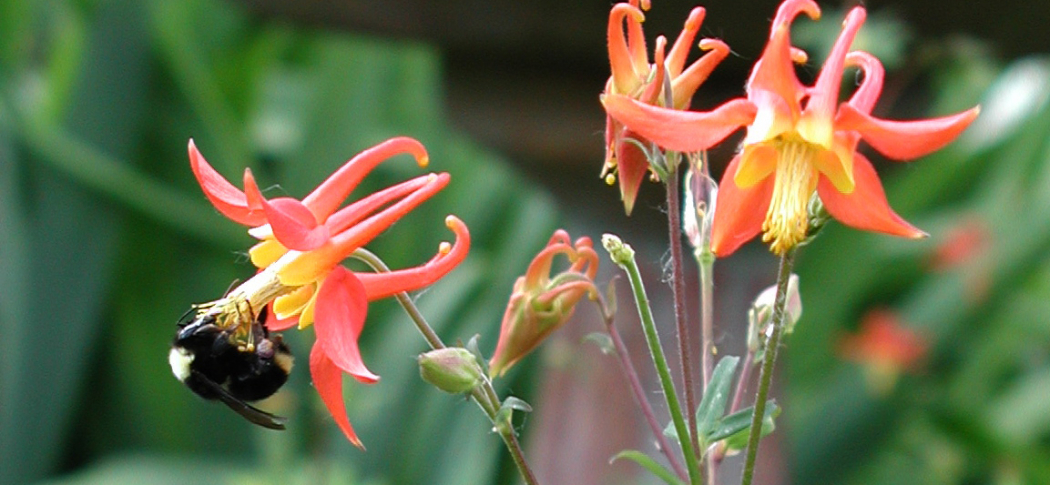
Reason 1:
Create a Backyard Wildlife Habitat
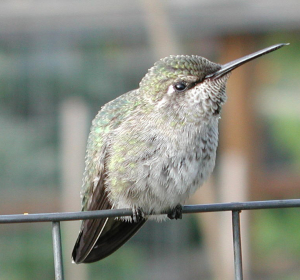 As our population grows, mankind encroaches on the natural world, pushing out species of both plants and animals—some to the state of extinction. There’s not a lot I can do personally to save the tiger or polar bear, but I can make sure that area songbirds have plenty of food and a place to nest, and that bees and butterflies have sources for nectar.
As our population grows, mankind encroaches on the natural world, pushing out species of both plants and animals—some to the state of extinction. There’s not a lot I can do personally to save the tiger or polar bear, but I can make sure that area songbirds have plenty of food and a place to nest, and that bees and butterflies have sources for nectar.
For photos and more details about the native plants I use in my garden in the Pacific Northwest and a few of the visitors I attract, see the slideshow I produced as part of my final project to become a certified Master Urban Naturalist through the National Audubon Society. You will see how I worked natives in with cultivated plantings to create a garden that is both beautiful and functional and brings the natural world to my back door.
It doesn’t take too much effort to turn your yard into a wildlife habitat. The basic requirements are water, food and shelter.
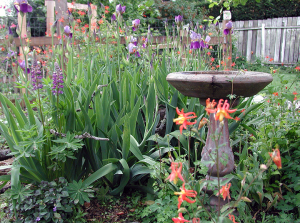 Birdbaths, ponds, and fountains are all attractive ways to add water to your garden. A birdbath is the easiest and least expensive option and can be a focal point that adds height to your landscaping. You do have to make the effort to keep it clean and stocked with fresh water—especially during the drier months. In winter, you’ll need to be able to supply fresh water even when the temperatures dip below freezing. I’ve written a post on that topic here. Ponds and fountains, though more expensive to install, provide the most natural source of water for wildlife. Birds love flitting through the stream of a fountain, and splashing water attracts butterflies and other beneficial insects.
Birdbaths, ponds, and fountains are all attractive ways to add water to your garden. A birdbath is the easiest and least expensive option and can be a focal point that adds height to your landscaping. You do have to make the effort to keep it clean and stocked with fresh water—especially during the drier months. In winter, you’ll need to be able to supply fresh water even when the temperatures dip below freezing. I’ve written a post on that topic here. Ponds and fountains, though more expensive to install, provide the most natural source of water for wildlife. Birds love flitting through the stream of a fountain, and splashing water attracts butterflies and other beneficial insects.
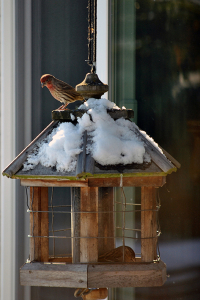 Feeders are a great way to entice specific birds like goldfinches (Nigerian thistle) and flickers (suet) to your garden, but birds love natural food sources best. That’s where the native plants come in. What to plant will depend on where you live. Here in the Pacific Northwest, I plant native columbine to attract both bees and hummingbirds, and a variety of camas and asters for the seed-loving birds. Sunflowers, though not native, are great annuals to attract chickadees. Mine have even caught the attention of a flock of parrots that have naturalized in a nearby park. Native huckleberry, red flowering currant, and black hawthorn all provide berries in the fall, and their flowers attract a variety of bees that also pollinate my blueberry bushes and apple trees.
Feeders are a great way to entice specific birds like goldfinches (Nigerian thistle) and flickers (suet) to your garden, but birds love natural food sources best. That’s where the native plants come in. What to plant will depend on where you live. Here in the Pacific Northwest, I plant native columbine to attract both bees and hummingbirds, and a variety of camas and asters for the seed-loving birds. Sunflowers, though not native, are great annuals to attract chickadees. Mine have even caught the attention of a flock of parrots that have naturalized in a nearby park. Native huckleberry, red flowering currant, and black hawthorn all provide berries in the fall, and their flowers attract a variety of bees that also pollinate my blueberry bushes and apple trees.
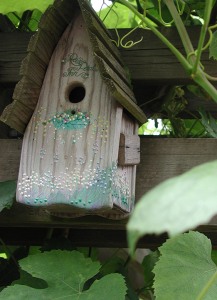 Shelter for birds comes in a variety of options, from birdhouses and nesting boxes to trees and shrubbery. But bees and other insects need homes too. Bumblebee boxes and mason bee nurseries are easily “hidden” in the garden and will help those pollinators turn flowers into fruit. Just be sure you buy items that are functional and not just ornamental. A homemade birdhouse can be a fun project; there are tons of sources for plans available online. A few of my favorite websites for FREE plans can be found on my Resources Page; check them out.
Shelter for birds comes in a variety of options, from birdhouses and nesting boxes to trees and shrubbery. But bees and other insects need homes too. Bumblebee boxes and mason bee nurseries are easily “hidden” in the garden and will help those pollinators turn flowers into fruit. Just be sure you buy items that are functional and not just ornamental. A homemade birdhouse can be a fun project; there are tons of sources for plans available online. A few of my favorite websites for FREE plans can be found on my Resources Page; check them out.
Additional reasons to incorporate native plants in your garden will be covered in subsequent blog posts. See my Resources Page for links to sources for more information on this topic.
- Words by Andrea Leigh Ptak
- March 25, 2014
- 1 Comment
Trackbacks/Pingbacks
[…] you’d like to learn more about providing habitat for the birds in your garden, see my previous post, Creating a Backyard Wildlife Habitat, and visit the website of the National Wildlife Federation. […]